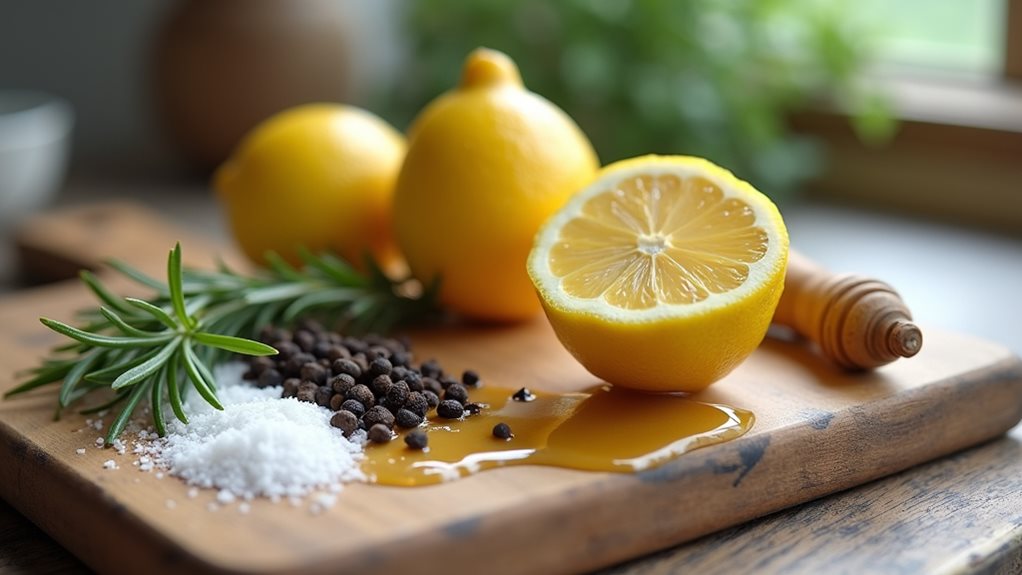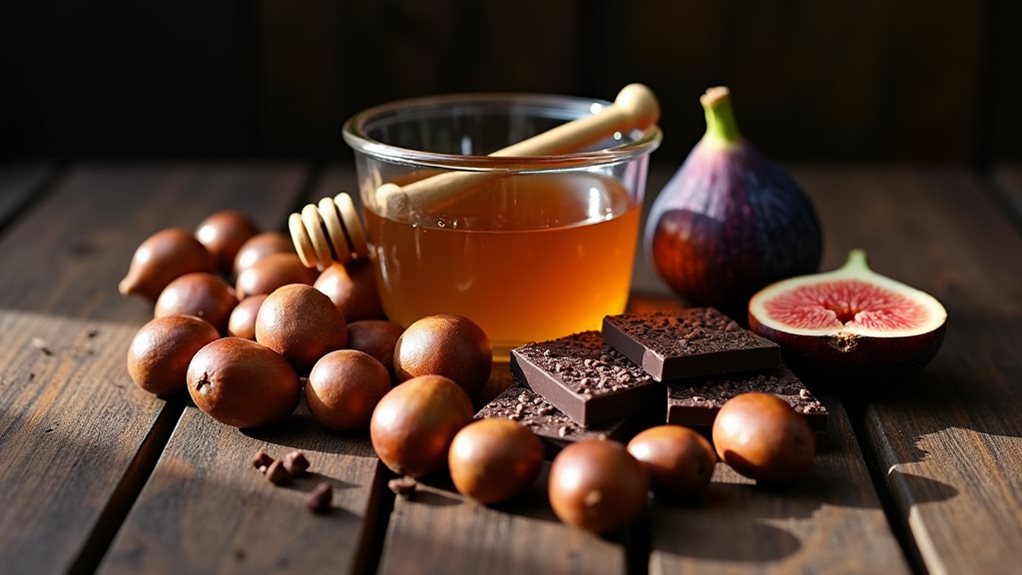Lemon pairs beautifully with herbs like basil, mint, and rosemary that enhance its citrus notes. You'll find it works wonderfully with sweet fruits like berries and mango to balance acidity, while savory elements such as garlic, olive oil, and capers create Mediterranean magic. Try unexpected matches like blue cheese or dark chocolate for sophisticated flavor combinations. Don't forget global inspirations—preserved lemons in Middle Eastern tagines or lemon-glazed Asian dumplings offer exciting possibilities. Explore these combinations to transform your everyday cooking into something extraordinary.
The Science Behind Lemon's Distinctive Flavor Profile
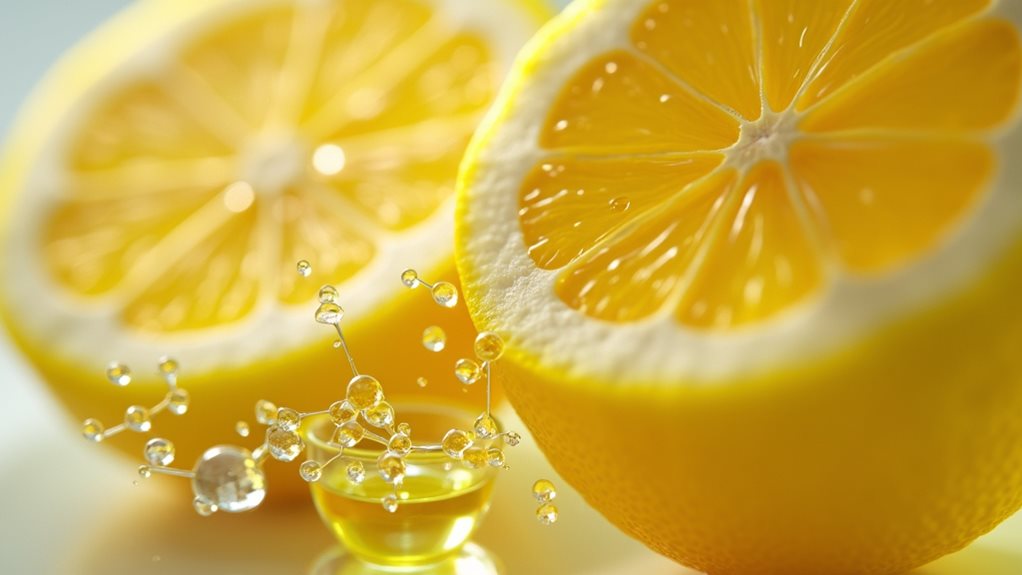
Citrus complexity defines the lemon's unmistakable profile, where chemistry and biology combine to create one of the world's most versatile flavors.
This liquid sunshine harnesses molecular precision, transforming ordinary dishes through its bright acidity and aromatic brilliance.
When you taste a lemon, you're experiencing a sophisticated interaction of sour compounds dominated by citric acid, with supporting roles from malic and ascorbic acids. These acids activate specific taste receptors, triggering that characteristic pucker response. The human tongue primarily detects four basic flavors, with sourness being the most prominent sensation when consuming lemons.
What truly distinguishes lemons, however, is the perfect balance between these acids and aromatic oils found primarily in the peel. The flavor profile can vary significantly between regular lemons and the less acidic Meyer lemons, which offer hints of bergamot and orange.
Limonene and citral isomers (neral and geranial) create that instantly recognizable lemon scent, while alpha-terpineol adds subtle woody notes.
The genes CitPH1 and CitPH5 hyperacidify vacuoles in the fruit, intensifying the sourness that cuts through other flavors in culinary applications.
Classic Culinary Pairings That Elevate Lemon's Zesty Notes
When it comes to culinary applications, lemon's bright, acidic character creates magical flavor combinations that have stood the test of time.
You'll find this versatile citrus fruit enhancing everything from zesty marinades for chicken to invigorating salads with crisp greens and tangy dressings.
The most celebrated lemon pairings include:
- Herbs & Aromatics – Basil, mint, and rosemary amplify lemon's citrus notes while adding complexity to seafood dishes and pasta.
- Sweet Fruits – Blueberries, mangoes, and pomegranates balance lemon's acidity with natural sweetness.
- Savory Elements – Garlic, olive oil, and capers create Mediterranean-inspired flavor profiles that showcase lemon's ability to cut through richness.
These combinations serve as jumping-off points for your own culinary experiments, inviting innovation in your kitchen. The refreshing combination of lemon and basil particularly shines in pasta salads with grilled chicken, offering a perfect balance of zesty and aromatic flavors. Ginger adds a wonderful dimension to lemon with its spicy, woody characteristics that create a warming counterpoint to citrus. The Ultimate Fruit Flavor Pairing Chart encourages discovering unexpected pairings that might transform your favorite lemon-based recipes.
Unexpected Molecular Matches for Creative Lemon Dishes
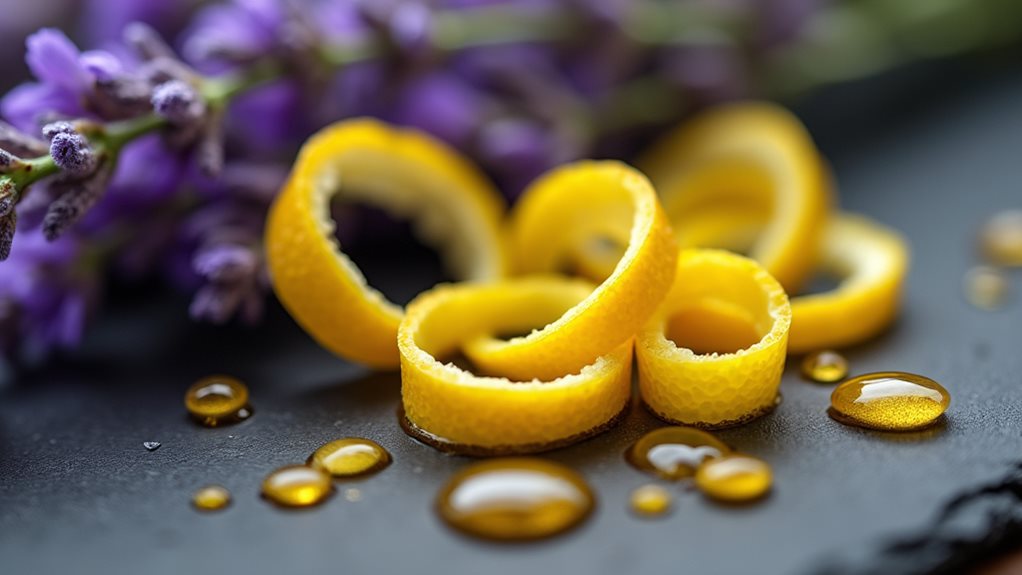
Beyond the traditional pairings, lemon's complex chemical profile opens doors to fascinating molecular combinations that you'd never expect to work. When you understand the science behind flavor networks, you'll discover that lemon's limonene and terpene compounds create surprising harmony with ingredients sharing similar volatile profiles.
Try pairing lemon with blue cheese in a savory mousse, where the acidity cuts through richness while complementing shared aromatic compounds.
For creative combinations, consider dark chocolate and lemon in a ganache, where temperature control becomes essential to maintain texture integrity. You can also explore molecular experimentation by infusing lemon with cardamom or ginger, creating depth that transcends cultural boundaries. However, be mindful that lemon's strong acidity (pH of 3 or below) can interfere with porcine gelatin's performance when creating mousses or gelled desserts. The analysis of food compatibility using high-performance liquid chromatography and gas chromatography helps identify these unconventional but harmonious pairings.
The Flavornet database can guide your innovative pairings, helping you balance sensory thresholds while crafting dishes that challenge conventional flavor expectations.
Craft Cocktails and Beverages Showcasing Lemon's Versatility
Lemon's bright acidity and aromatic complexity create the foundation for some of the world's most celebrated cocktails and beverages.
From classic whiskey sours to innovative limoncello creations, you'll discover that lemon adapts seamlessly to both traditional and contemporary mixology approaches.
The versatility of this citrus superstar allows for remarkable cocktail innovations when paired with spirits like gin, vodka, and bourbon. For a refreshing and elegant option, try the classic lemon drop cocktail made with vodka and triple sec, rimmed with sugar for a sweet-tart balance. The French 75 offers a sophisticated alternative that combines gin, lemon juice, and champagne bubbles for a festive and tangy experience.
- Try infusing your simple syrups with ginger or basil for unexpected flavor dimensions in lemon-forward drinks.
- Experiment with lemon garnishes beyond the typical wedge—consider dehydrated wheels, twisted peels, or lemon foam.
- Combine lemon with floral elements like St. Germain or herbal components for sophisticated signature drinks.
Global Cuisine Inspirations for Lemon-Forward Recipes
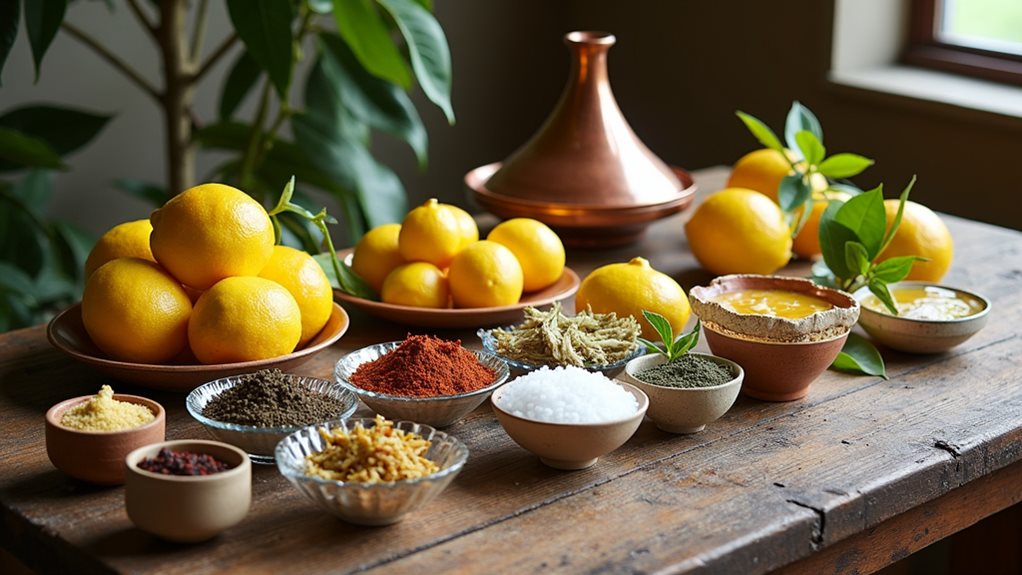
From bustling street markets in Bangkok to rustic trattorias along the Amalfi coast, lemon's distinctive brightness serves as a culinary ambassador across global cuisines.
Mediterranean influences shine through dishes like lemon chicken orzo and fresh tagliatelle with grilled shrimp, where citrus notes complement herbs and olive oil perfectly. Italian cuisine showcases this beautifully in dishes like mushroom risotto where fresh lemon zest brightens the earthy umami flavors.
In Eastern kitchens, Asian adaptations transform traditional recipes with unexpected twists—imagine lemon-glazed dumplings or Thai lemon soup balancing sour notes with aromatic spices.
Middle Eastern chefs elevate preserved lemons in tagines and stews, where the bright and forward flavors of preserved lemons combine with warm spices like cinnamon and ginger to create complex flavor profiles, while European traditions incorporate lemon into both savory Spanish garlic shrimp and sweet French crème brûlée.
You'll find lemon's versatility extends to South American kitchens too, where it brightens Argentinean asado marinades.
Much like the comprehensive model outputs found in alpaca_eval's repository, these global lemon pairings provide valuable insights for evaluation and inspiration in culinary development.
Experiment with these global inspirations to expand your culinary horizons beyond familiar lemon applications.
Seasonal Pairings to Highlight Lemon Year-Round
The changing seasons offer unique opportunities to showcase lemon's vibrant character through complementary ingredients that reach their peak throughout the year.
You'll find spring pairings like asparagus with lemon sauce and strawberry-lemon shortcake create bright, invigorating combinations that celebrate new growth.
Summer pairings shift to cooling watermelon-lemon salads and zesty grilled chicken with lemon glaze, offering relief from heat while enhancing seasonal produce.
- Autumn pairings incorporate lemon to brighten hearty dishes like squash soup and lemon-roasted Brussels sprouts.
- Winter pairings feature warming lemon-ginger hot toddies and cranberry-lemon sauce for holiday meals.
- Year-round strategies include using zest in baking and balancing rich dishes with lemon's acidity.
For an exquisite autumn combination, try adding lemon juice to butternut squash risotto where the acidity beautifully balances the natural sweetness enhanced through roasting the squash.
Sweet and Savory Balance: Mastering Lemon in Diverse Dishes
When balancing sweet and savory elements in culinary creations, mastering lemon's versatility becomes an essential skill for both novice and experienced cooks.
You'll find that lemon zest provides subtle citrus notes in both lemon bars and pepper chicken, while its acidity expertly balances richness in savory desserts like cheesecake with herbs.
Try incorporating lemon marinades for proteins such as shrimp scampi or garlic butter chicken, where the bright acidity cuts through fattier components.
For a more complex flavor profile, experiment with pairing lemon with complementary ingredients like cardamom in meatballs or garlic in pasta dishes.
The classic Scallopine al Limone demonstrates how lemon's tartness can transform a simple veal dish into something extraordinary.
Consider how lemon's bright acidity could enhance a roasted beet salad by replacing traditional balsamic vinegar for a lighter, more refreshing flavor contrast against the earthy sweetness of the beets and creamy goat cheese.
Frequently Asked Questions
Is Lemon Flavor Affected by the Growing Region?
Yes, you'll find lemon flavor varies considerably based on growing conditions. Regional varieties develop distinct profiles due to climate, soil type, and water availability, offering innovative culinary possibilities beyond standard uses.
Can Lemon Essence Substitute Fresh Lemon in Flavor Pairings?
You can substitute lemon essence for fresh lemons, but expect different results. Lemons vs. essence differs in flavor intensity—essence offers concentrated flavor without acidity, while fresh lemons provide complex, natural notes for innovative pairings.
How Do Artificial Lemon Flavors Differ in Pairing Abilities?
Artificial lemon flavors offer consistent flavor intensity but lack natural complexity. You'll find they pair well with sweet ingredients, while their predictable artificial acidity works better in manufactured products than in nuanced culinary applications.
Are Meyer Lemons Interchangeable With Regular Lemons in Recipes?
Like cousins with different personalities, Meyer lemons and regular lemons aren't fully interchangeable. You'll need to adjust recipes when substituting, as their distinct flavor profiles mean Meyer's sweeter, less acidic nature transforms your culinary creations differently.
What Health Conditions Might Affect Perception of Lemon Flavors?
You'll notice altered taste perception with dysgeusia, ageusia, COVID-19, or olfactory disorders. Nutritional deficiencies can decrease your citrus sensitivity, while psychological factors may transform how you experience lemon's complex flavor profile.
Final Thoughts
You've now explored the remarkable versatility of lemon across culinary traditions worldwide. Did you know that a single lemon contains roughly 15-20 calories but delivers more than 50% of your daily vitamin C requirements? From elevating seafood dishes to transforming cocktails and desserts, lemon's bright acidity and complex aromatic compounds make it an essential ingredient in your culinary toolkit. Experiment with these pairings to bring new dimensions to your cooking.

